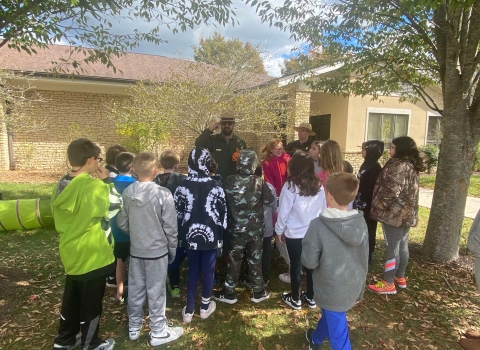Crystal clear water makes its journey through the Highlands region of New Jersey, trickling out of wooded hillsides and collecting in cool streams. This scenic area, protected with the assistance of funding through the U.S. Fish and Wildlife Service’s Highlands Conservation Act (HCA) grant program, spans north-central New Jersey and provides vital natural resources, including fresh drinking water, to New Jersey residents.
“We’re standing in front of a pond that gives great groundwater recharge. The tributaries to the Rockaway Creek run through here as well,” said Bill Millette, open space coordinator for Hunterdon County, describing one of New Jersey’s recently conserved properties in the Highlands region.
This 75-acre property, soon to be named Rockaway Creek Preserve, marks the 100th property conserved with the assistance of the HCA. Located in Tewksbury Township, Hunterdon County, this property will offer many benefits to the residents of New Jersey and beyond.
“This acquisition would not have happened at all without the Highlands grant program.” said Millette.
The New Jersey Highlands Water Protection and Planning Council serves as the facilitator for these projects, connecting project leads with the HCA funding needed to complete their projects.
Heading north, a recent addition to the Nancy Conger West Brook Preserve in West Milford Township will expand the preserve by 46 acres, adding a large pond and associated wetland.
“The property has a trail network through it, and the public is welcome,” said Sandy Urgo, vice president of land preservation and land stewardship for The Land Conservancy of New Jersey.
Urgo has embarked on the long process of returning the disturbed landscape to a more natural state.
“Parts of West Brook Preserve are in very good condition. There are other parts that are very challenged, [due to] a number of invasive species invasive species
An invasive species is any plant or animal that has spread or been introduced into a new area where they are, or could, cause harm to the environment, economy, or human, animal, or plant health. Their unwelcome presence can destroy ecosystems and cost millions of dollars.
Learn more about invasive species and the work to eliminate them. We try to be very thoughtful. We try to limit our disturbance and our impact and maximize our uplift,” said Urgo.
The preserve, which once experienced expansive excavation for peat moss farming, has undergone restorative efforts to remove dams, fill man-made ditches, and reconnect streams to their floodplains. The landscape and wildlife have already begun to show a positive recovery.
“The biggest uplift that we see here is amphibians and fish because of the hydrologic restoration, but we also enjoy a lot of common species: black bear, great blue heron, ducks, and red-spotted newts,” she said.
The newly acquired pond and wetland were conserved with the assistance of HCA funds. Work to reclaim these areas will soon be underway.
“The Highlands Conservation Act has been terrific — that money was key to acquiring the addition to the preserve,” said Urgo.
Circling back to Tewksbury Township, another recently acquired property will create a number of new opportunities for passive public recreation. Here in the countryside, approximately 63 wooded acres have been conserved through the assistance of the HCA.
“These are headwaters to Rockaway Creek. The critical water resources, groundwater recharge, and surface seeps, it is really a unique headwater property,” said Ken Klipstein, director of watershed protection at New Jersey Water Supply Authority. Klipstein also serves on the boards of trustees for the New Jersey Conservation Foundation and the Tewksbury Land Trust.
Klipstein described the extensive plans for the property, including managing invasive species and creating trails to offer recreation opportunities to the public and the local equestrian community. However, the most significant feature of the property is the drinking water resources it supports.
“Rockaway Creek flows into the north branch of the Raritan, which is a water supply. Protecting these areas where the water is originating is the most important thing to note about the property,” Klipstein said.
Through the assistance of the HCA grant program, the State of New Jersey has been able to conserve 2,395 acres of land that will contribute to the protection of clean drinking water. The Highlands region of New Jersey provides drinking water to more than 300 New Jersey municipalities that are home to 70% of the state’s population.
Conservation of each property in the New Jersey Highlands region has been accomplished through coordination by the New Jersey Highlands Water Protection and Planning Council, the New Jersey Green Acres Program, local land trusts, the U.S. Fish and Wildlife Service, as well as local and state partners.
“This is a testament to sticking with it and doing what’s right to protect these critical areas,” Klipstein said. “I’m grateful for the Highlands Conservation Act.”







